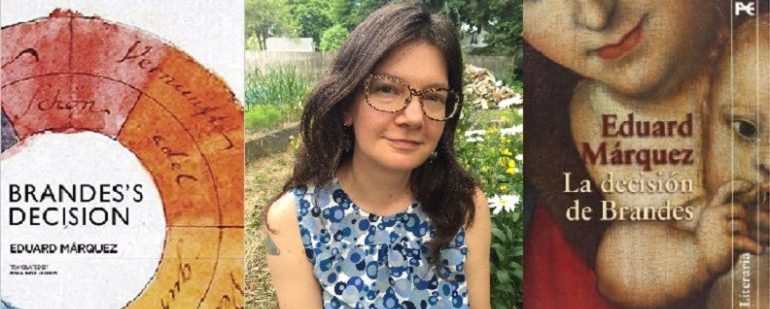Language as a “Banner of Identity”: An Interview with Mara Faye Lethem

I first encountered Mara Faye Lethem’s translation work in the novel Papers in the Wind by Eduardo Sacheri (2014, Other Press), an emotionally devastating Argentinian book about soccer and friendship. Since then, she’s won an English PEN Award for her work translating The Whispering City by Sara Moliner. In this interview, we’re discussing the short novel Brandes’s Decision, originally written by Eduard Márquez in Catalan and published in 2006, recently brought to an English-reading audience by Hispabooks, a Madrid-based publisher. Brandes’s Decision tells the story of Brandes, a broken man looking back on a life full of tragedy at a moment when he has very little to look forward to.
Graham Oliver: As far as I know, this is the first work I’ve read translated from Catalan. Can you tell us some about the literary situation for present day writers who choose to write in Catalan? I understand Eduard Márquez has previously written in Spanish—is working in Catalan seen as a political act, an aesthetic choice, or maybe a move to reach a specific audience?
Mara Faye Lethem: Catalan is a language with written texts dating from the 12th century and a publishing history that began in the 15th. At the same time, it has suffered official repressions of varying degrees since the early 18th century, and during Spain’s most recent dictatorship, it was banned. It was illegal to even speak Catalan, and when Franco died in 1975, 85.5% of Catalans couldn’t write their own language. While today over 40 percent of the world’s 7,000 languages are endangered—a language dies out approximately every 14 days—Catalan has made an amazing comeback. Thanks to concerted efforts by the Generalitat, and primarily the use of Catalan as the language of instruction in schools, the number of Catalans who can write the language has almost been turned on its head, it’s over 70 percent. Catalan is the ninth most spoken language in Europe (yet not recognized as an official language by the European Union), the 19th most used on Twitter, and the 23rd most translated worldwide. I see this progression over the last forty years as a hero’s journey fueled by a love of language and literature. And the writers in Catalan, many of a certain age are philologists and are working out of not only love but also a commitment to Catalan’s survival.
So, to answer your question, yes, it remains a somewhat political act, and an aesthetic choice, and increasingly just natural for some younger Catalans. And that “naturalness” is hard won by people whose love of their lovely language led them to brandish it as a banner of identity and an instrument of social inclusion. Of course, there are wonderful Catalan authors who write in beautiful Spanish as well.
GO: You primarily work with Spanish (writing in both Spanish and Catalan) and Argentinian authors. Of South American Spanish dialects, I understand that Argentina’s is one of the closest to Spain’s Spanish, but I’m sure there’s still a big gap in idioms and reference points between the two. Can you talk some about how you tackle figuring out the unique turns of phrase you encounter from each dialect or from Catalan? Do you rely entirely on the author, or do you have a community you turn to, or do you use the Internet as a reference tool?
MFL: All translation involves research into both aspects of subject matter and turns of phrase. The Internet is an extremely useful tool for translators, despite its randomness and porn bias, as are smart local friends who enjoy word play. In recent years I have developed relationships with many of my authors, and that is a wonderful resource. After Barcelona, my Spanish-language spiritual connection is strongest with Mexico, but the books I’m offered are, of course, market driven to a large extent, and that has led me to deeper ties with Argentina. Spanish is a very rich language, and that’s part of the fun. Being a translator is a fabulous way to be constantly learning new things.
GO: Brandes’s Decision has a repeated reference to orpiment, which I had never heard of. In fact, I assumed it was some kind of tool, but it turns out to be an orange-yellow mineral used to tint paints. The book is full of painting and real artists—how do you think the original Spanish/Catalan audience’s relationship with this material differs from the English/American audience that will be reading it now?
MFL: I don’t know that I can speak in broad terms about how those audiences relate to such material, but I would say that the theme of art and artists’ place in a continent ravaged by war has a particular resonance in Europe that it doesn’t in America, just because we have much more of a disconnect from the wars we are engaged in.
GO: One thought I had at the end of this book is that the main character would be unusual among typical American protagonists in that he never seems to do anything unsympathetic or wrong. With mainstream American literature, we seem to want our protagonists to have a serious character flaw in one way or another. Do you think this is a difference in literary expectations, or might it have to do with the subject matter (a veteran of WWI who flees Nazi Germany)?
MFL: Of course, he is the narrator so his version could be suspect, but I think he is quite haunted by having left his son Konrad behind in Berlin.
GO: One of my favorite parts of this book is the way it handles the ineffable trauma of trench warfare and the Holocaust. The whole book is circling that suffering, unable to confront it directly.
MFL: Even after Adorno requestioned his idea of the barbarism inherent in writing poetry after Auschwitz, it remains potent, and certainly resonates for some Catalan authors. This can be thought of in the broader sense of: what are art’s possibilities and responsibilities in societies marked by violence and oppression? I suppose the 20th-century European situations are easier to extrapolate into a philosophical plot than the more diffuse neo-liberal, drone-warfare evils of today.
GO: What should we be reading from Catalan or Spanish literature? Regardless of if it’s translated yet or not.
MFL: Mercè Rodoreda and Pere Calders are modern classics for a reason, brave Catalans who wrote in exile and kept the flame alive. I wish I were translating Mariana Enríquez, whose work is dark and compelling, and forthcoming in English soon.
Of my authors, I most recommend Javier Calvo, whose latest novel is a punk and brilliant spy thriller of the Spanish Transition; Toni Sala, whose short and potent The Boys came out last fall with Two Lines Press; and Patricio Pron, whose new novel is set in Fascist Italy and revolves around a writers’ conference.
I have a constantly growing list of authors I’d like to translate and it currently includes Jordi Nopca, Víctor García Tur, Kiko Amat, Hebe Uhart, Josefa Contijoch, Manuel Baixauli, and Francisco Casavella. I get a weird hunch about certain authors that I can’t really explain; it’s more visceral than intellectual and has yet to ever pan out into a contract.
For another interview with Mara Faye Lethem, check out this conversation between her and Toni Sala (author of The Boys) at Two Lines Press’s website.


